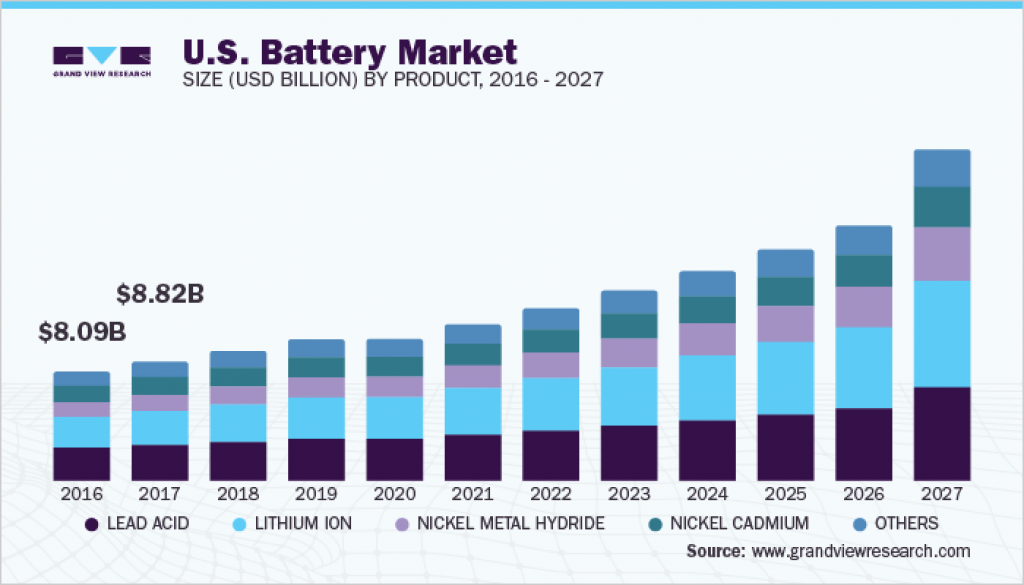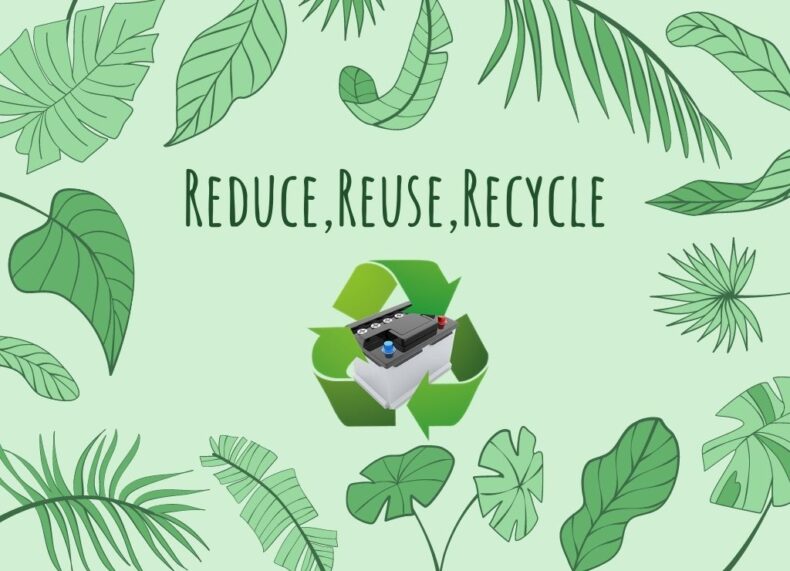Solar batteries combined with a solar charger are the best options to store your solar energy production and use it at any time through an inverter. They are durable, but after a few years they will reach the end of their life and you might ask yourself: are solar batteries recyclable?
Yes, they are. However, the recycling process could be challenging depending on the battery technology. Lead-acid batteries are the most recycled of all consumer products (up to 99% recycling rate), only 5% of all lithium-ion batteries (also including home electronics) are recycled.
Currently, there are 2 types of solar batteries:
- Lead-acid: AGM and GEL (99% recycle rate)
- Lithium batteries: mostly LiFePo4 (5% recycle rate)
It is expected that at least 11 million tons of used lithium-ion batteries will accumulate worldwide until 2030.
Recycling solar batteries is therefore a critical issue that needs urgent addressing
This article will break up the topic as follows: first, it’ll look at the actual production volumes of solar batteries; Then, it’ll describe the materials that make solar batteries and how you can limit their environmental impact when they reach the end-of-their-life; and finally, you’ll find out where to recycle your lithium and lead-acid batteries in the US.
Table of Contents
Solar Batteries Global Production: Facts and Figures

- In 2020, the global production of lead-Acid batteries was 360 GWh with 71% being used as car batteries (SLI battery), and 10% (36 GWh) as solar batteries.
This sector is expected to experience an annual growth rate of 3.4% from 2020 to 2030, with solar batteries accounting for 12% (52 GWh) of global production.
- In comparison, the global production of Lithium batteries was 500 GWh in 2020 and expected to grow to more than 3,000 GWh by 2030. 600% growth due to the Electric Vehicle (EV) markets tremendous expansion.
In 2020, solar batteries accounted for 18% of all lithium batteries produced, with an expected annual growth rate of up to 14% by 2030.
To summarize all these figures:
- Global solar battery production and demand is increasing
- Lead-acid technology will experience a steady growth,
- Lithium battery is the fastest growing technology
- Lithium battery production is already higher than lead acid
It is currently estimated that a lead-acid battery for solar storage has a life duration of 3-4 years while a lithium battery could last up to 10 years.
Recycling solar batteries seems to be the best option to reduce the overall amount of battery waste.
To understand how one can recycle a solar battery, we first need to understand what materials and parts make up a solar battery.
What Is A Solar Battery Made Of?
First, let’s check the lead-acid battery for solar energy storage:
Lead-acid – Flooded, AGM and GEL Solar Batteries
Lead-acid solar batteries are quite an old technology, as they were invented in 1859 by Gaston Planté. They benefit from having more than a century of innovation, and their production process is standardized. There are 3 types of lead-acid batteries – flooded, maintenance-free (AGM and GEL). However, all three mainly share the same components:
- Battery casing (ABS plastics)
- Electrodes (Lead, Pb)
- Electrolyte (Sulfuric acid H2SO4)
- Membrane separator (Polymer plastic)
In the end, a lead-acid battery contains the following elements that could potentially be recovered by recycling:
- Lead (65%)
- Acids (16%)
- Plastics (10%)
- Other (10%)
Lithium battery: LiFePo4
Lithium batteries like LiFePo4 are quite new, they were discovered in the early ’80s and introduced to the market in the late ’90s. Their inventors were awarded the Nobel chemistry prize of 2019. Indeed, they are a major breakthrough in electricity storage, enabling countless applications from mobile consumer electronics to solar energy storage systems.
In a recent article, we demonstrated how superior they are compared to lead-acid batteries.
They share with lead-acid a similar working principle based on electrochemistry, therefore, you will find the following elements in a LiFePo4 battery:
- Battery casing
- Electrodes (LiFePo4, Carbon)
- Electrolyte (Lithium salt, Li+)
- Membrane separator (Polymer plastic)
However, unlike lead-acid which are “simple” systems, the materials and fabrication process of lithium batteries are far more complex.
A lithium battery is a blend of multiple critical elements, that could possibly be recovered by recycling. In a typical lithium battery, you will find:
- Iron, Fe (28%)
- Phosphate, Po (18%)
- Aluminium, Al (5%)
- Lithium, Li (3%)
- Carbon, C (13%)
- Plastics (8%)
- Other (25%)
Now that you have a clearer picture of what’s inside a solar battery, let’s see why recycling is a critical issue for both the battery industry and the environment.
Why Is It Important To Re-Use And Recycle A Solar Battery?

At the end of their life, your solar batteries are considered waste that contains hazardous materials and therefore should be properly disposed of.
Several options are open, you could:
- Re-use/Up-Cycle the batteries, for less demanding operations, the market of second-hand lithium batteries is very dynamic.
- Recycle the solar batteries: recover all materials available while preserving their quality
- Recover for energy purposes (incinerate some parts of the batteries)
- Dispose the final waste in a landfill
Obviously, we are trying to avoid the last two: recover and dispose, which are the most harmful to the environment.
Re-use and recycle are parts of the so-called “circular economy”, they contribute to extending the life duration of the batteries and their materials.
Re-use Solar Batteries
If your battery is still working it might be possible to use it for other applications. There is a growing market for second-hand lithium batteries:
- Turn electric vehicle lithium batteries into solar batteries
- Re-use laptop batteries in a DIY Powerwall
However, you will always reach the point where second-hand batteries wear out, and recycling will be the only option. Let’s have a look at the 5 advantages of recycling solar batteries.
5 Benefits Of Recycling Solar Batteries
Recycling solar batteries have many benefits both for the environment and the economy:
1. Recover Critical Battery Materials
The aim of recycling solar batteries is to recover as much basic material as possible (Lead, Carbon, Iron, Cobalt, Lithium…) at the highest level of purity possible. Ideally, the recycled and the original material should have the exact same properties.
2. Protect The Environment
Recycling solar batteries is critical because both technologies (lead-acid and lithium) contain highly toxic materials:
- lead, lithium oxide,
- Fluids, gels: sulfuric acids, lithium salts
Recycling protects against dreadful environmental consequences (water, soil, and air contamination) if the batteries were to be left in the wild.
3. Generate Incomes
Recycling solar batteries can be a source of income. Indeed, industrial recycling and metal recovery processes are becoming cost-effective compared to mining extraction.
This is particularly true for high-value materials like gold, silver, copper, and more. For example, the Belgian company Umicore is the largest precious metals recycling facility in the world, selling 100% recycled gold and silver bars.
Several US companies are also generating income while recycling solar batteries. This business has a great growth potential over the next ten years.
4. Reduce Energy Consumption And CO2 Emissions
The manufacturing process of solar batteries requires large quantities of energy. Combining different studies, we found out that you need between 97 Kwh and 180 Kwh to produce 1 kWh of battery. This generates between 150kg and 250kg of CO2 per kWh of battery. And this figure doesn’t include raw material extraction and refining processes.
It is proven that recycling results in energy and CO2 savings. For example 75% energy savings for lead, 72% for iron and steel. In the US, in 2018, 3.7 million tons of aluminum were produced by recycling, saving enough electricity to cover the needs of 8 million homes.
5. Develop And Improve The Circular Economy
As previously mentioned, recycling is part of the circular economy. Millions of tons of batteries are produced every year, and will therefore reach end-of-life within a few years. The goal of a circular economy is to keep them as long as possible in the economy. Recycling solar batteries strongly increase the life duration of materials and systems before disposing of them.
In addition, it pushes scientists and experts to develop advanced recycled processes with higher material recovery rates and energy efficiency.
How To Recycle Lithium Batteries In The US?
It is assumed that only 5% of all lithium batteries are recycled. This figure is quite low and is expected to improve in the coming years. Currently, we can recycle up to 96% of a lithium battery.
The recycling process of a lithium battery is complex due to the blend of materials that make up the batteries. It involves 3 main steps:
- Opening
- Physical separation
- Material recovery
The first two steps are rather easy to set up. The material recovery part is the trickiest as it involves advanced extraction technics such as pyrometallurgy and hydrometallurgy.
In the US and Canada, the lithium battery recycling market is expanding. There are several companies already offering their services.
- RedwoodMaterials , works with Tesla to recycle their batteries
- Retrievetech in Ohio is recycling batteries and recovering materials for 25 years
- OnTo Technology is an expert in the whole lithium battery recycling process with multiple patents
- LiCycle claims to recover more than 95% of all materials of a lithium battery
Ultimately, you could drop off your used solar batteries at a Call2Recycle collection point near your home. Call2Recycle is the largest consumer battery recycling program in the US.
How To Recycle Lead-Acid Batteries In The US?
As previously mentioned, lead-acid battery is mature battery technology, and its recycling rate is the highest of all consumer products, reaching 99% in the US!
To recycle your lead-acid batteries, the US Environmental protection agency (EPA) recommends to:
- Return your batteries to a battery retailer
- Drop your batteries at a local household hazardous waste collection program
Is It Safe To Recycle Solar Batteries?
Batteries contain highly toxic materials and chemicals. Recycling them is not safe and should be done with extreme caution.
Unfortunately, lead-acid battery recycling is a major source of pollution in several countries, including the US.
Lead is poisoning the soil and the water, generating deadly diseases in the local population, especially among children. This is true for industrial recycling plants and exacerbated by small scales recycling operations in Africa, India, and China.
For example, in India, 90% of lead-acid batteries are recycled in open-air by the informal sector.
Recyling Batteries – Key For The Future
In the end, solar batteries are recyclable, but their recycling process is a potential threat to the planet and its inhabitants.
We could think of two radical options for a cleaner and more circular solar battery industry:
- Lead-acid battery production ban
- Solar battery eco-conception
By 2030, most countries will ban the sale of cars fueled by fossil fuel because of their pollution, we should do the same with lead-acid batteries.
In addition, all new lithium batteries must be eco-conceived: recycling their parts and materials should be a concern for manufacturers as early as the battery conception stage.

